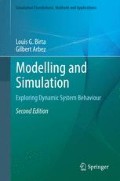Abstract
The focus of this chapter is conceptual modelling in the DEDS domain. The presentation begins with a discussion of the intended purpose of a conceptual model stressing, in particular its role as a communication platform for all stakeholders in a modelling and simulation project and, as well, its role as a specification for the simulation model (i.e. computer program) that will carry out the simulation experiments. The need for both structural and behavioural considerations in developing a conceptual model is emphasized. The notion of events necessarily plays a central role in these considerations, and considerable care is taken to provide a clear characterization of this notion because of its importance in the subsequent discussions. The chapter presents an activity-based conceptual modelling framework called ABCmod. Consistent with identified requirements, this framework is organized around entity structures (that capture structural requirements) and behavioural constructs (activities and actions that capture behavioural requirements). Attributes provide the essential constituent of the former, while events provide the essential constituent of the latter. Input and output characterization is based on concepts introduced in Chap. 3. To facilitate dialog with different segments of the stakeholder community, the ABCmod framework provides both a high level and a detailed level for the conceptual model formulation. A number of examples are included to illustrate the application and efficacy of the ABCmod framework.
Access this chapter
Tax calculation will be finalised at checkout
Purchases are for personal use only
Notes
- 1.
A possible goal might be to determine how best to allocate a new part-time employee so that operational efficiency is maximized.
- 2.
These world views are examined in Chap. 5.
- 3.
- 4.
In the discussions that follow, the relevant interpretation will be context dependent.
- 5.
Set member identifiers start at 0; this reflects the common programming convention for indexing arrays.
- 6.
- 7.
The reader should observe that, to be meaningful, a discussion of events within a DEDS modelling context cannot be exclusively concerned with conditional events; i.e. at least one scheduled event needs to be included.
- 8.
Our notion of the conditional activity coincides with the perspective of an activity taken by Hills [4].
- 9.
In the procedure identifiers, ‘x’ is a place holder for either DVP or RVP, thereby indicating either a deterministic value procedure or a random variate procedure.
- 10.
There is a data modelling phase associated with the input table as described in Sect. 4.3.2.4.
- 11.
While the presentation suggests a group of male philosophers, this should not be taken literally since the group is, in fact, gender balanced.
References
Birta LG, Zhang M (1998) SimNet a conceptual modeling tool for simulation. In: Proceedings of the summer computer simulation conference, 1998
Gershwin SB (1991) Hierarchical flow control: a framework for scheduling and planning discrete events in manufacturing. In: Yu-Chi H (ed) Discrete event dynamic systems. IEEE Press, Piscataway
Haas PJ (2002) Stochastic Petri nets: modelling, stability, simulation. Springer, New York
Hills PR (1973) An introduction to simulation using SIMULA. Publication No. S55. Norwegian Computing Center, Oslo
Jensen K (1997) Coloured Petri nets, basic concepts, analysis methods and practical use (3 volumes). Springer, London
Kreutzer W (1986) System simulation: programming styles and languages. Addison-Wesley, Sydney/Wokingham
Martinez JC (2001) EZStrobe: general-purpose simulation system based on activity cycle diagrams. In: Proceedings of the 2001 winter simulation conference, IEEE Press, Arlington, VA, pp 1556–1564
Peterson JT (1981) Petri net theory and the modeling of systems. Prentice-Hall, Englewood Cliffs
Pidd M (2004) Computer simulation in management science, 5th edn. Wiley, Chichester
Pidd M (2007) Dynamic modeling in management science. In: Fishwick PA (ed) Handbook of dynamic system modeling. Chapman & Hall/CRC, Boca Raton
Robinson S, Brooks R, Kotiadis K, van der Zee D-J (eds) (2011) Conceptual modelling for discrete-event simulation. CRC Press, Boca Raton
Robinson S (2004) Simulation: the practice of model development and use. Wiley, Chichester
Robinson S (2011) Conceptual modeling for simulation: definition and requirements. In: Robinson S, Brooks R, Kotiadis K, van der Zee D-J (eds) Conceptual modelling for discrete-event simulation. CRC Press, Boca Raton, pp 3–30
Shannon RE (1975) Systems simulation: the art and science. Prentice Hall, Englewood Cliffs
Shi JJ (2000) Object-oriented technology for enhancing activity-based modelling functionality. In: Jones JA, Barton RR, Kang K, Fishwick PA (eds) Proceedings of the 2000 winter simulation conference, Orlando, Florida, 10–13 Dec 2000, pp 1938–1944
Tadao M (1989) Petri nets: properties, analysis and applications. Proc IEEE 77:541–580
Wang J (1998) Timed Petri nets, theory and application. Kluwer, Boston
Wang J (2007) Petri nets for dynamic event-driven system modeling. In: Fishwick PA (ed) Handbook of dynamic system modeling. Chapman & Hall, Boca Raton, pp 24(1)–24(17)
Zeigler BP (1976) Theory of modeling and simulation. Wiley, New York
Zeigler BP, Praehofer H, Kim TG (2000) Theory of modeling and simulation: integrating discrete event and continuous complex dynamic systems. Academic, San Diego
Author information
Authors and Affiliations
Rights and permissions
Copyright information
© 2013 Springer-Verlag London
About this chapter
Cite this chapter
Birta, L.G., Arbez, G. (2013). A Conceptual Modelling Framework for DEDS. In: Modelling and Simulation. Simulation Foundations, Methods and Applications. Springer, London. https://doi.org/10.1007/978-1-4471-2783-3_4
Download citation
DOI: https://doi.org/10.1007/978-1-4471-2783-3_4
Published:
Publisher Name: Springer, London
Print ISBN: 978-1-4471-2782-6
Online ISBN: 978-1-4471-2783-3
eBook Packages: Computer ScienceComputer Science (R0)

